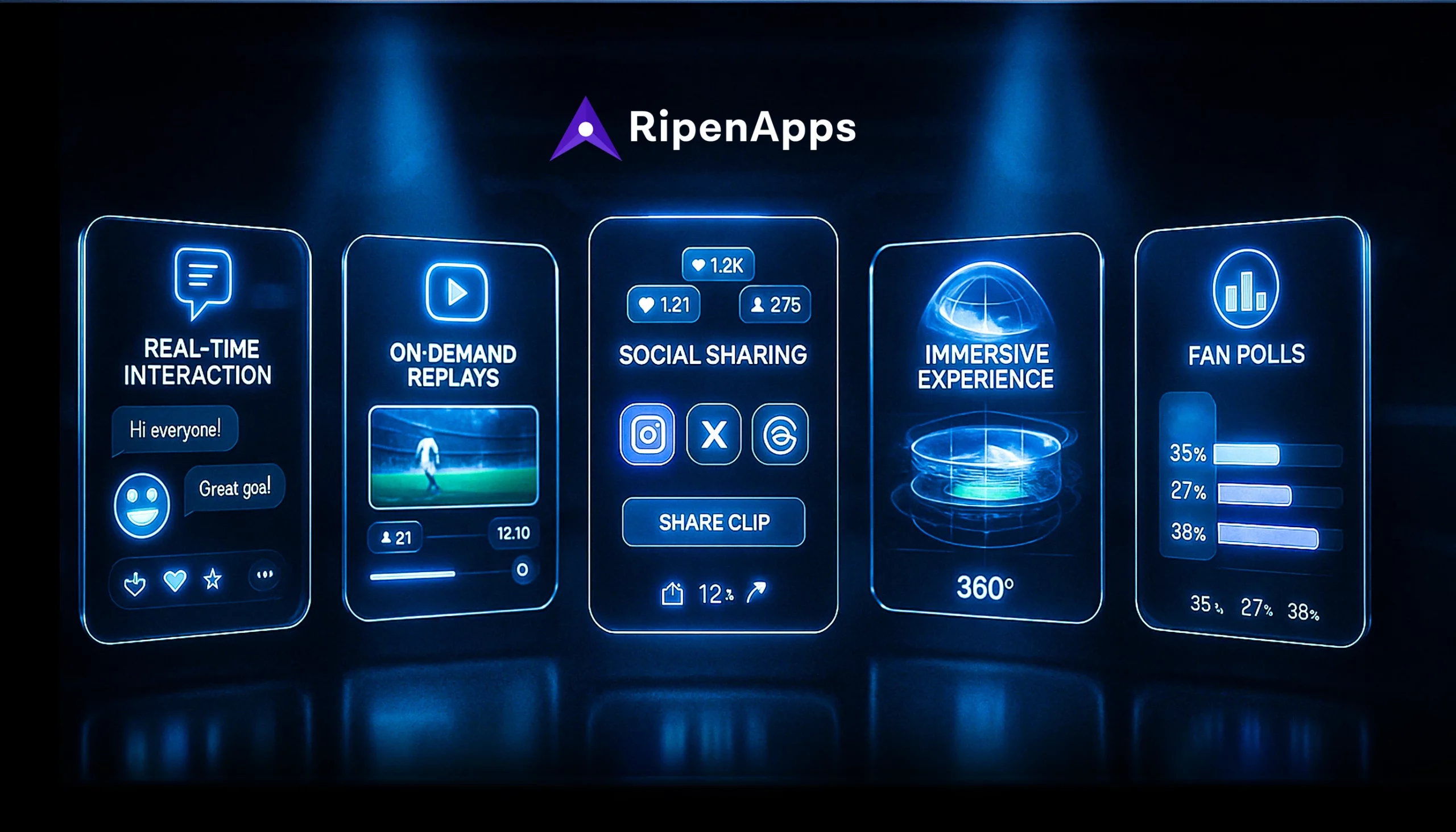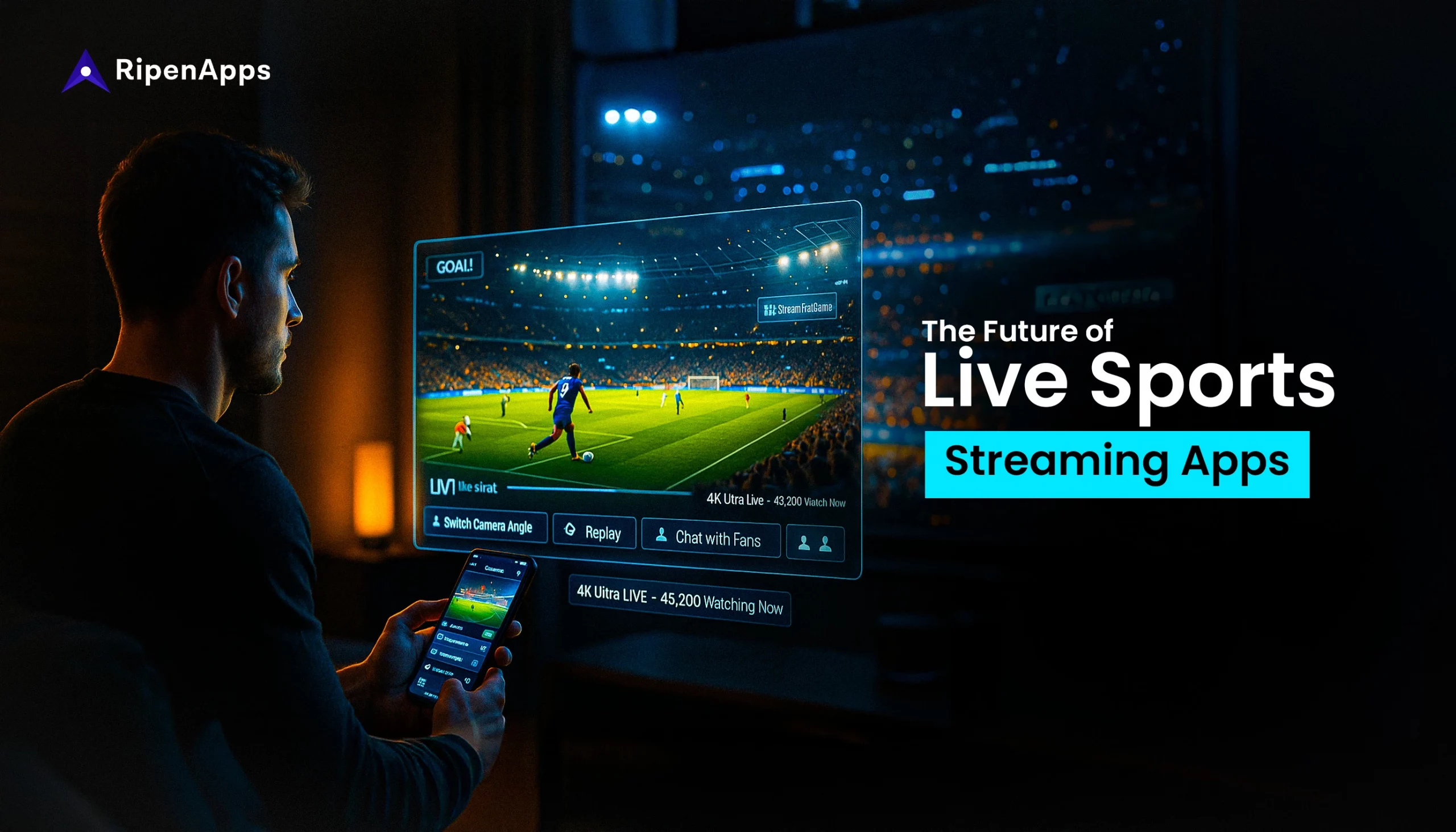Remember the time when watching a live match meant being glued to your TV screen, remote in hand, and hoping your cable provider wouldn’t drop out. But today, live sports consumption has broken free from the couch and is now thriving in the palms of billions.
Whether it’s a nail-biting IPL finale, a last-minute Champions League goal, or a buzzer-beater in the NBA, fans now expect instant, anywhere access to live action — in HD, on-demand, and interactive.
This seismic shift from traditional cable to mobile-first, OTT-driven sports viewing is a revolution in the sports tech industry. One that’s being fueled by next-gen tech like 5G, edge computing, AI-powered personalization, and real-time fan engagement tools.
And at the center of this digital storm lies an unprecedented opportunity, especially for forward-thinking and innovation-hungry startups. Legacy broadcasters no longer dominate live sports streaming. The gates are wide open. From niche sports leagues to hyper-local fan communities, the playing field is now ripe for business disruption.
For startups and businesses that seek to enter the sports tech space, the message is clear: The future of sports is digital, and the time to build is now. Today, in this blog, we will be exploring the future of live sports streaming apps and how startups can take advantage of the growing business opportunities in this sports tech space.
So let’s kick off then.
Table of Contents
What is a Live Sports Streaming App?
The live sports streaming apps are digital platforms that allow users to watch sporting events and programs in real time from phones, tablets, smart TVs, or laptops. It acts as your own virtual sports stadium on the go, highlighted with features far beyond mere watching of a game.
These apps come with different features that traditional TV does not provide, being linear and limited. For instance, on-demand viewing, multiple camera angles, real-time stats, replays, and interactivity such as live chats, fantasy league integrations, and AR overlays, among others.
The Rise of Live Sports Streaming: Why It Is Booming
The notion that subscribing to a live sports streaming service was once a luxury has now become a global standard. The second, and perhaps most important, way in which live sports streaming is changing how sports fans consume their desired sports games is that millions of users have been moving away from cable TV to their phones. Hence, the demand for real-time and on-the-go access to matches has just skyrocketed today. Let’s take a look at the currently rising trends that are pushing the field of live sports streaming.
1. Latest Statistics on Global Sports Viewership and OTT Trends
This period is certainly the most explosive for the sports streaming industry. The figures tell a compelling insight. According to recent industry reports, in the USA, over 80% of global sports fans now prefer streaming live sports digitally over traditional TV broadcasts.
According to Grand View Research, the global sports streaming platform market size is projected to rise from $33.93 billion in 2024 to $75.17 billion by 2030. The live streaming segment alone is estimated to skyrocket to $41.84 billion by 2030 at a CAGR of 21.5%.
So, what is causing this explosion? Accessibility, affordability, and the sheer convenience of being able to choose when and where to watch sports are the answers. Cricket from India, football from Europe, or MMA from the U.S., live sports events are fast-moving into digital ecosystems, and fans are loving every bit of it.
For the startups, this is more than just another consumer shift. It is an open invitation to build a sports streaming app that meets the lifestyle and needs of today’s fans.
2. Impact of 5G, AI, and Cloud in Transforming Live Sports Streaming
Live streams, interspersed with 4K visuals of HD quality, are three forces that are poised to reshape the future of live sports streaming apps. 5G offers ultra-low latency and extremely high speeds.
Artificial intelligence in sports apps overlays real-time data, generates automated highlight reels, and customizes the delivery of content down to the hyper level. Cloud computing in sports, with proponents like AWS and Google Cloud, allows for seamless scaling even at the highest traffic, say, during the World Cup finals or Super Bowl weekends.
Currently, sports tech startups and top fantasy sports app development companies are using these technologies to provide a cutting-edge and engaging sports streaming experience to the masses. Thus, indeed, the spreading adoption of such technologies supports the propagation of live sports streaming services.
Changing Audience Expectations: What Today’s Sports Fans Want

The modern sports fan is different. It is almost like the modern audience lives through the events and not merely watches them. Thanks to digital convenience, fast speed of the internet, and an appetite for deeper connection, today’s fans want more than just passive viewing. Below are the current trends and changes in today’s sports audience.
1. Real-Time Interaction: Live Chats, Fan Polls, and Social Sharing
One-way communication is old news now. Today’s spectators want equal co-creation conversations during games. Real-time chat features such as sending emoji reactions, forcing decisions, etc. And subtle polls create a peculiar atmosphere as though thousands of others are watching the game with you from anywhere in the world.
Such engagement tech turns the fan into a participator, so apps that promote social engagement in sport are big winners when it comes to retention and virality.
2. Demand for Personalization, Multi-Angle Views & AR Overlays
Modern sports fans don’t just sit back to enjoy a match. They are interactive, informed, and digitally savvy. This interaction includes much more than the game itself; they’re seeking an immersive, customized journey. This shift in sports consumer behavior is one of the biggest reasons why live sports streaming apps are dominating the future of sports fan engagement.
For startups ready to innovate, this is the golden era to reimagine what sports streaming could look like. The sports streaming industry is now about crafting compelling, tech-driven fan ecosystems.
3. On-Demand Replays, Highlights & Player Stats on the Go
In the 24/7 digital world, sports fans no longer sit and wait for highlight reels to air on TV. They want that gratification instantly and within the app. Be it a rewind of a stunning goal, a breakdown of a player’s performance, or real-time data analytics in sports, sports streaming platforms are now expected to deliver content that adapts to each moment of the game.
An excellent way for startups to make their mark is here, where the features of the sports app truly matter. Incorporation of AI-based highlight creation or player comparison tools helps convert a random viewer into a power user and dramatically increases stickiness.
4. Localization, Multiple Language Support
With sports being a global passion, cultural and linguistic personalization is non-negotiable. Fans in Tokyo, Toronto, or Tamil Nadu want the same match. But in their own language, with regional context and culturally relevant commentary.
This is a mighty growth lever for the sports industry. Sports apps that provide multi-language support, regional content filters, and localized push notifications stand a much better chance at cracking the underserved markets and building lasting fan loyalty.
Read Also : Building Multilingual Apps in Flutter: Localization & Internationalization Method
Market Opportunities For Startups in Live Sports Streaming
The playing field in live sports streaming apps is no longer reserved for broadcasting giants. With changing fan behaviors, emerging technologies, and global digital access, a new wave of opportunity has opened up, especially for startups willing to innovate. Here’s where the real game-changing potential lies:
1. Untapped Localized Sports Leagues and Niche Audience
Most of the time, mainstream sports get all the limelight. Local leagues and niche groups of fans lying just below constitute a treasure trove largely ignored. For example, kabaddi in rural India, and college football in Southeast Asia, or women’s rugby in Africa-there are fierce, loyal audiences, but the digital backend is absent.
Startups can develop a live sports streaming app that caters to these segments, creating first-mover advantages with high engagement rates and lower competition. These aren’t just fans; these are communities who are willing to land on the right digital bridge. And a smart and tech-powered startup could be the bridge to fill this gap.
2. Hyper-Personalized Household Sports Content for Gen Z and Gen Alpha
Young people don’t really “watch sports.” They want to be a part of the experience through ownership and interaction. They expect feeds customized to their interests, AI-generated highlight reels, and some bite-sized content to fit their lifestyle.
For founders exploring innovative app ideas for the sports industry, personalization remains the heart of relevance. You can find a dedicated UI UX design agency to craft interactive design for your sports app that can turn a passive viewer into a die-hard superfan.
3. B2B Opportunities: Custom Sports App Development Solutions
The sports app development market is moving beyond the consumer facade. Leagues, media houses, and even individual sports clubs are now actively seeking white-label or custom sports apps that help them engage audiences directly.
This creates a B2B goldmine for startups that can offer tailored live streaming platforms, analytics dashboards, or fan engagement toolkits. But to maximize this potential, you will need to find a fantasy sports app development company to build to help you open up entirely new revenue verticals.
4. Integration of Sports Betting and Fantasy Sports
With online sports betting becoming legal in several global markets, it is also getting larger by the minute. There is a stark blur between viewing and participation. Live match feeds integrated with fantasy dashboards, betting odds, and prediction engines make the live sports streaming and betting experience more intriguing today than ever before.
Therefore, this intersection is not only boosting retention but also unlocking scalable monetization in sports tech. Startups that can securely and ethically merge live sports streaming with sports betting layers will be seen as frontrunners in the next wave of the future of sports streaming apps.
Read Also : How Much Does It Cost To Build A Fantasy Sports App?
5. Integration of NFTs and Digital Collectibles
We’re entering a new era of digital fandom where fans can own a moment, not just watch it. NFTs tied to match-winning goals, digital trading cards, or exclusive collectible clips are turning passive memories into tradeable assets.
For startups, the opportunity is vast and powerful in merging streaming, blockchain, and fan loyalty. Digital sports collectible integrations value building the sports marketplace around digital memorabilia or offering NFT unlocks for in-app purchases. That is what is defining the new economy of fans right now. And smart startups will be the ones who capitalize on it.
Hot Features That Every Next-Gen Live Sports Streaming App Must Have
What truly sets apart next-gen live sports streaming apps is their ability to deliver immersive, intelligent, and interactive sports experiences that align with today’s fan expectations. So when you are building a live sports streaming app, you must incorporate top features that today’s fans look for.
Being among the renowned mobile app development company USA, we know what trends and features are in demand in the market today. The following is a list of must-have features for any next-generation sports streaming platform:
- Ultra Low-Latency Live Streaming
- Multi-Camera Angle Switching
- 4K/8K HD Streaming Support
- AI-Powered Highlight Generation
- Interactive Fan Features
- In-App Live Stats and Analytics Dashboard
- Personalized Feed & Content Curation
- Instant Replay & Video-on-Demand (VOD)
- Fantasy Sports & Betting Integrations
- Multilingual Audio & Subtitles
- AR/VR Viewing Capabilities
- Cross-Platform Support (Mobile, Web, Smart TVs)
- Offline Viewing Mode
- Push Notifications & Smart Alerts
- Secure Payment & Subscription Models
The Global Playing Field: Regions Ripe for Disruption
While major leagues and established markets dominate headlines, the real game-changing potential for live sports streaming apps lies in emerging regions. Places where digital adoption is booming, but streaming experiences are still underdeveloped, or rather, fragmented. For the visionary startup and investor, these markets become opportunities for innovation, acquiring fans, and long-term growth. Let us look into where the next major opportunities are and how to tap into them.
1. Emerging Markets Like India, LATAM, SEA, and MENA
Mobile penetration has skyrocketed in countries such as India, Latin America (LATAM), Southeast Asia (SEA), and MENA (Middle East & North Africa), with data costs falling and millions of young fans still eager for real-time sports content. Traditional broadcasters have mostly been sidelined or simply fail to provide mobile-first, localized experiences for these regions.
By launching live sports streaming platforms designed for bandwidth-variable environments and culturally relevant formats, new players can capture audiences at scale. India’s regional cricket tournaments, Brazil’s grassroots football, and esports leagues in Indonesia are just a few examples of massive, underserved fan bases ready to stream if the sports experience is built right.
2. Opportunities at Regional League, University-Level Sports, Esports
Though global sports rake in huge numbers, deeper loyalties come from local love. Regional leagues and university-level sports stand to make a significant impact, especially when equipped with smart digital infrastructure and interactive fan tools.
Esports is also changing the perception of what sports content looks like, especially for Gen Z and Gen Alpha. Streaming platforms that give esports the kind of coverage typical for traditional sports will garner rapid traction from a tech-savvy fan base.
3. Localize As a Growth Hack: Language, Culture, Fan Base Adaptation
Language support, region-specific commentary, culturally relevant UI, and even the gamification model itself would all make the difference between adoption and retention in the world of global sports. Live sports streaming platforms that embrace these nuances from Day 1 are the quickest to scale and nurture stronger emotional resonance with their users.
Startups that think along these lines hold the key to unlocking the huge monetization in sports tech through hyper-local ads, regional sponsorships, and culturally apt premium features.
Why Now Is the Best Time for Startups to Enter Sports Tech?
The sports world is undergoing a digital transformation like never before. Today, sports tech startups have a rare and time-sensitive opportunity to lead it. As fan behaviors evolve, technology advances, and monetization avenues diversify, the barriers that once kept newcomers out of the game are rapidly disappearing.
From legacy broadcasters and billion-dollar leagues, what was once unsafe terrain is considered like fertile soil for the bold, innovative disruptors. The perfect storm is born for startups not simply entering but reshaping the future of sports entertainment: AI-driven content personalization, unattended regional leagues, and a booming mobile-first audience.
If building a live sports streaming app is your thing, this is the best time. Why? Here are those reasons-
- Global fan base shifting from cable TV to mobile-first live sports streaming apps.
- Rapid 5G rollout enabling seamless, low-latency live experiences
- Affordable access to cloud, AI, and real-time streaming infrastructure
- Rise of underserved markets and untapped regional sports leagues
- The explosive growth of esports, fantasy gaming, and micro-content demand
- Investor interest soaring in sports tech and digital fan engagement startups
- Fans demanding hyper-personalization, interactivity, and immersive content
- The market is fragmented, giving startups a first-mover advantage in niche segments
Conclusion
The rise of live sports streaming is a revolutionary shift in the current sports industry. From regional cricket matches to global football finals, fans across the world are turning to digital platforms for faster, smarter, and more personal ways to experience the game. Today’s fans want connection, customization, and content that moves with them, and they want it now.
For startups, this shift is a once-in-a-generation opportunity. By partnering with a custom mobile app development company like RipenApps that has a keen understanding of modern fan behavior and the right sports tech, even early-stage players can compete with legacy giants.
So, if you’re a founder, visionary, or investor eyeing your next big move, this is your signal. The infrastructure is ready. The demand is exploding. The only question is — will you stream the future, or will you build it?
FAQs
Q1. What future trends should we expect in the live sports streaming app market?
You can expect AI-driven personalization, 5G-powered ultra-HD streaming, multi-camera viewing, interactive features like polls and chats, AR/VR experiences, and integrated live betting to shape the future.
Q2. What are the challenges in the live sports streaming app industry?
Key challenges include acquiring streaming rights, ensuring low-latency performance, handling peak traffic loads, piracy concerns, and meeting evolving user expectations for seamless, interactive viewing.
Q3. How do live sports streaming apps make money?
They generate revenue through subscription plans, in-app ads, pay-per-view content, brand partnerships, live betting integrations, and licensing or distribution of sports content.
Q4. Is it profitable to invest in live sports streaming technology?
Yes, with the market growing rapidly and user engagement at all-time highs, it’s a profitable space, especially for startups offering niche, innovative, or interactive features that enhance viewer experience.












 India
India USA
USA Australia
Australia Canada
Canada UK
UK UAE
UAE
